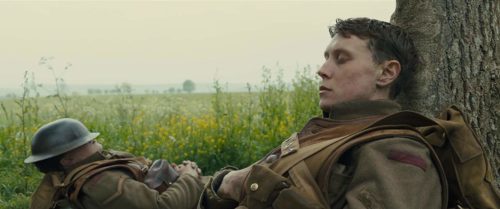
We do not seek peace in order to be at war, but we go to war that we may have peace.
– Augustine
1917 is a brutal and beautiful film. The shots of falling cherry-blossoms complemented by the terrific lighting contrast scenes of corpses integrated seamlessly into the landscape. Mercy is met with violence. Blood is spilled in acts of self-survival and milk is given in acts of self-sacrifice. The fire of the sun touches gently on rolling green pastures and the inferno of war bears down like a hellscape on a quaint French village.
War films have a way of disturbing me far more than any horror film. Perhaps it is how close war films can come to reality that unsettles me. One can sit at a comfortable distance from evil in a horror film, but a war film requires us to reckon with the evil in human history. I take it as a good rule of thumb: don’t trust a war film that doesn’t unsettle you.
War often takes place in beautiful places and brings to ruin beautiful things—friendships, fraternity, creatures, and culture. Some have argued that 1917’s aesthetic trivializes the brutality of war, but it seems to be doing the very opposite. The film produces something uncanny in the way that it constantly flips back and forth between scenes of awe and scenes of horror and then sometimes blends the two together (so much so, I almost stepped out of the theater for some reprieve). I imagine that this was intentional on the director’s part, perhaps wanting the audience to recognize that war does not just take place in hellish landscapes; it takes place in villages, among livestock, with the sun illuminating everything to reveal both the former beauty and barbarism of battlegrounds. War takes place between humans even when everything seems inhumane.
1917 is about ruin and the preservation of beauty. It is about what we have that we lose in war, but it is also about why war is often necessary to preserve what is beautiful. It rides a hard line of showing the complexity of war, and it shows that sometimes we must choose destruction for the sake of peace and preservation.
I have a quote framed in my room that simply states, “As long as we have our stories there is hope.” Sentimental as it may sound, there is a truth to it. We tell each other stories to help us make sense of our lives and the evil within them. And these stories can continue to provide hope long often after their authors are gone, even when violence seems to have its final say over mercy. In this sin-soaked and absurd world of ours, sometimes all we are left with is fragments of beauty, things worth fighting to cultivate and preserve. To take a phrase from Tolkien, we fight “the long defeat” not in the hopes that by human measure we will ultimately preserve such beauty and peace, but knowing that, when all is said and done, there is a final victory to come, one which will usher in and restore the brokenness of beautiful things to a an even brighter state than before. And by the hand of the One who will ultimately conquer evil, we can rest assured.
Image credits: IMDb

COMMENTS
One response to “1917 and the Ruin of Beautiful Things”
Leave a Reply













Thanks for your wonderful reflections on 1917. I experienced similar emotions. The contrast between the cherry blossoms and death was striking. I often had to raise my eyes above the level of the mud-encased bodies in order to avoid the ghastly picture of death’s ugliness. I recall doing the same thing when when being in the presence of my 96 year old dad in his death when rigamortis was setting in. I found myself being able to bear only glimpses of this horrible sight before turning away.
Thank God he loved the world so much, he didn’t look away from the ugliness of death but instead came to destroy its grip by becoming death for us.